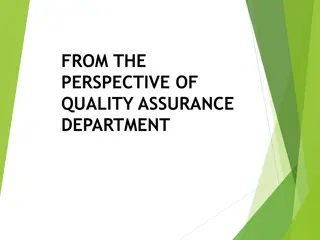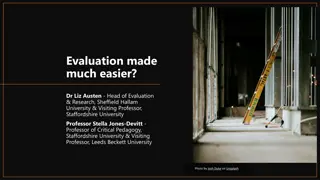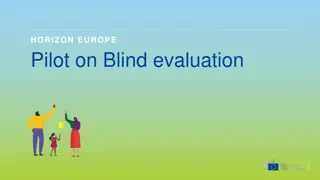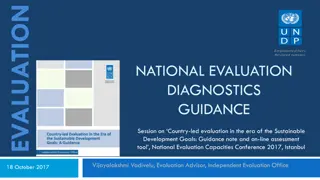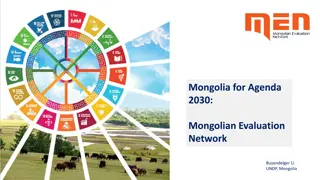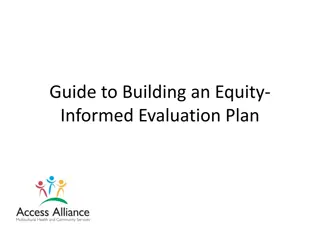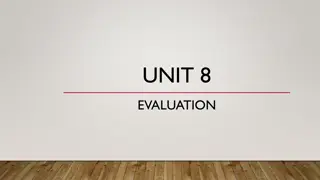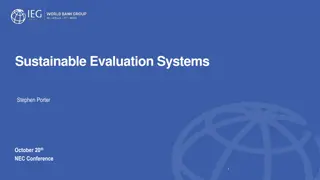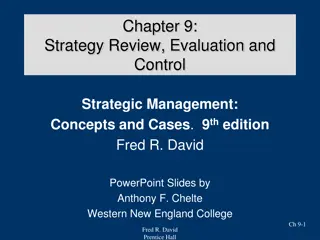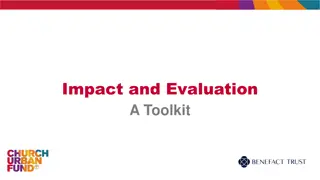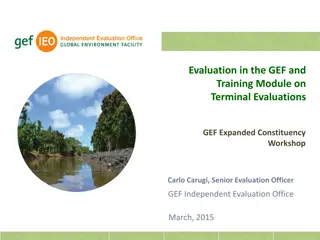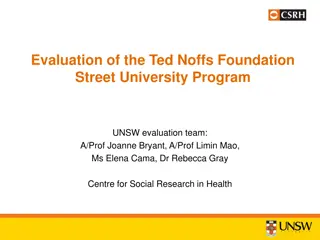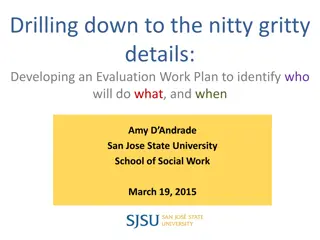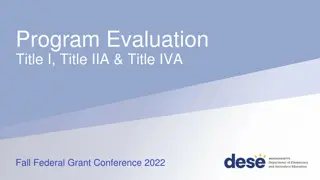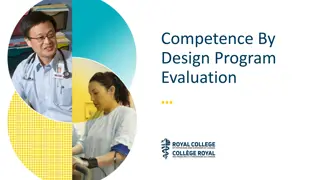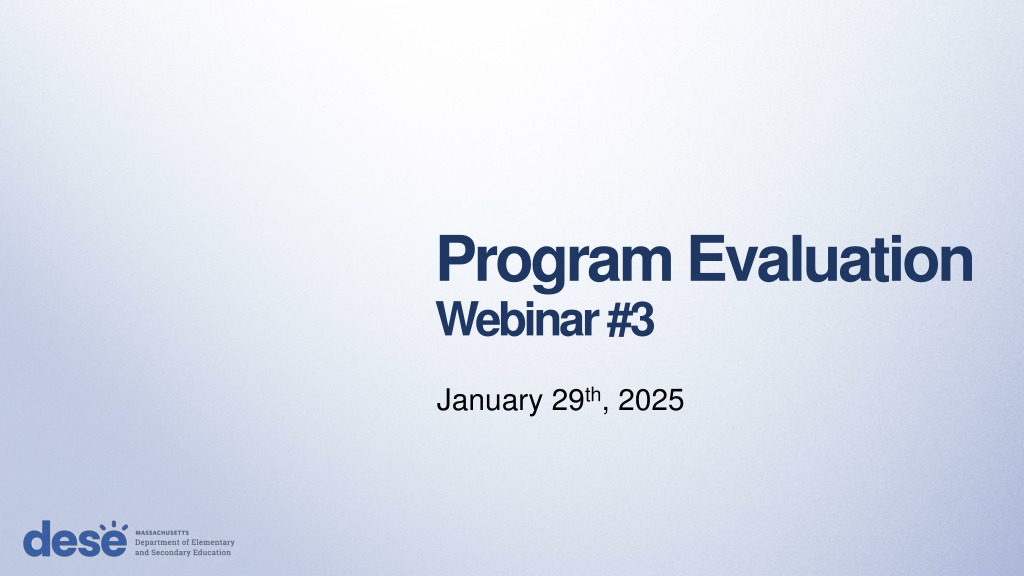
Effective Strategies for Program Evaluation Procedures
Gain insights on foundation data analysis, resource utilization, and the importance of evaluating Title grant programs to meet federal mandates. Learn the key components of program evaluation procedures and upcoming webinar topics for support.
Download Presentation

Please find below an Image/Link to download the presentation.
The content on the website is provided AS IS for your information and personal use only. It may not be sold, licensed, or shared on other websites without obtaining consent from the author. If you encounter any issues during the download, it is possible that the publisher has removed the file from their server.
You are allowed to download the files provided on this website for personal or commercial use, subject to the condition that they are used lawfully. All files are the property of their respective owners.
The content on the website is provided AS IS for your information and personal use only. It may not be sold, licensed, or shared on other websites without obtaining consent from the author.
E N D
Presentation Transcript
Program Evaluation Webinar #3 January 29th, 2025 1
2 Introductions Leif Jacobsen DESE, Federal Programs Team Kendra Winner DESE, Research and Evaluation Coordinator 2
Objectives By the end of today s convening, participants will... Know where to find resources to support choosing metrics and measures Understand foundation data analysis concepts including how to compare beginning and midyear data Understand the key components of the Program Evaluation Procedure document. Be familiar with revisions to the DESE Title Grants Program Evaluation Workbook Be familiar with the answers to frequently asked questions about program evaluation. 3
Why is this important? Federal law mandates that as a condition of accepting Title grant funding, a district must annually evaluate its Title grant programs. You should be regularly using data to: Ensure you re addressing the needs you identified Identify what s going well Identify what needs to improve Use findings for planning and improvement. Document progress against your goals 4
Your Feedback and Upcoming DESE Support Upcoming Webinars As a result, we are planning five webinars in the upcoming year: August: Overview of Program and Evaluation Goals November: Theory of Action & Data Collection Today: Writing Your Program Evaluation Procedure Document March 26th:Writing Your Program Evaluation Summary Document June 10th (Federal Grants Conference): Connecting All the Pieces & External Communication Plan 5
Where to Find Evaluation Resources 1. On DESE Website, go to Federal Grant Programs -> General Resources for Federal Grant Programs -> ESSA Program Evaluation 6
Workbook Checklist Step Question Done? What skill(s) do we need on our team and who has those skills? 1. Identify members of the team 2. Conduct Needs Assessment and Design Theory of Action What are the short- and long-term goals of our program? What key actions will get us to our goals? 3. Define program goal and evaluation questions What did we design our program to do? What do we want to find out? How would we know? What is measurable and attainable? How and when do we collect the data? 4. Create a data collection plan What are the key components of this submission and how do we write it? How do we analyze our findings? 5. Write Program Evaluation Procedure 6. Analyze Data What are the key components of this submission and how do we write it? How do we report our findings and what do we do because of our findings? 7. Write Program Evaluation Summary 8. Report, discuss, and apply evaluation findings 7
Reminder: Metrics for Data Collection The data that you need to collect will depend on what you are evaluating. Some common metrics are: Student achievement/growth: MCAS, DIBELS, Access, ANET, other internal Assessments Attendance: Attendance rate, tardy rate Extracurricular engagement: participation rate Parent Engagement: Parent attendance at parent-teaching meetings, PTA, etc. See Workbook pages 25-27 8
Align your data with your program objective and your evaluation questions. 9 9
Example: Family Engagement Common measure: family attendance at various events parent/teacher conferences, curriculum night, social events. But what does that tell you about: Whether home-school communication about a child s academic or other issues is working well? Whether parents understand and engage in activities at home to help and encourage schoolwork? Whether families understand and support the Title services their child is eligible to receive? 10
Focus data analysis on understanding the story the data is telling. 11 11
Qualitative Analysis Think Aloud Focus groups, interviews, open-ended survey responses, etc. A first careful read without taking notes or focusing on specifics yet. A second read for themes/topics and highlight/underline key words, phrases, or quotes. Look for repeated ideas and assign labels (e.g., areas for improvement, successes). Organize by grouping similar themes and topics together. Look for connections and conclusions. Ask what are the main messages ? Check for bias and inconsistencies. Summarize your findings. See Workbook page 33 12
Quantitative Analysis Think Aloud: Comparing BOY and MOY Big Picture Evaluation Questions Are students on or off track to meet grade level expectations? What can we learn about how our program supported students who are on track? What can we learn about what our program can do differently to better support students who are off track? 13
Quantitative Analysis Think Aloud Students and student information: Student name Relevant student characteristics such as gender, EL, SWD, etc. Other relevant information: Intervention focus (e.g., letter recognition or comprehension, basic math operations, etc.) Classroom Time of day/instruction missed (e.g., midday, science pullout, etc.) Scores BOY, MOY, EOY Benchmarks 14
Quantitative Analysis Think Aloud: Comparing BOY and MOY Make note of anything interesting and any questions that come to mind. 1) Look at the raw data student by student and for relevant student groups 2) Look at the differences between BOY and MOY, benchmarks, actual growth, and needed growth. 3) Look at descriptive statistics (means, ranges) for relevant student groups 15
BOY and MOY Analysis Think Aloud Child BOY score minus BOY Benchmark Child MOY Score minus MOY Benchmark Child 1 -10 -2 Child 2 -26 -10 Child 3 -4 0 Child 4 -18 -8 Child 5 +3 +2 3) MY NOTES Look at the differences between BOY scores, MOY scores, and BOY and MOY benchmarks: One child exceeded both BOY and MOY benchmarks All students closed the gap on the MOY benchmark Students who needed more growth needed between 2 and 10 points of growth to meet MOY benchmark 16
Title I Required Evaluation Submissions 1) Document 1: Program Evaluation Procedure This is where you explain the processes that your district uses to evaluation its program. 2) Document 2: Program Evaluation Summary This is where you analyze your district s data and discuss implications for future program cycles. 17
Program Evaluation Procedure: Key Components In this document, you will: Describe your district s Theory of Action for this grant and the main program goals that are aligned to the TOA. Describe the key stakeholders involved in this evaluation and the role that each stakeholder has played in the evaluation cycle. Provide a rough annual timeline of your evaluation cycle, including goal setting, data collection, analysis, and report dissemination. Describe which data are collected and how your team analyzed the table. Describe how final evaluation documents are shared with the community. 18
Evaluation Procedure: TOA & Stakeholders Theory of Action & Program Goals Roles of Key Stakeholders What is your district s theory of action for the program? Who is leading the evaluation work? Who has been consulted, what is the role of each stakeholder? At a high altitude, how do you hope that your grant will produce change that improves outcomes for students? How have key strategic decisions been made? What are your program s long and short-term goals? How do you are these goals aligned to the program s theory of action? 19
Evaluation Procedure: Timeline & Data Collection Evaluation Timeline Data Collection What the is rough timeline of your evaluation cycle? (In other words: what time of year do you set your goals? When do you collect data? When do you write these reports? When do you disseminate them?) Which pieces of data do you collect? Why did you decide to collect these? How do you collect the data? *One option could be to represent this as a visual timeline.* 20
Data Analysis and Dissemination Data Analysis Dissemination What steps did your team take to analyze the data? Describe here. How were these final evaluation documents shared with the community? Which key community stakeholders were provided with the documents? Some Possible Examples Compared BOY, MOY and EOY benchmark assessments Tabulated teacher survey results Identified themes from open ended questions Some Possible Examples Posted publicly on website Shared at school board meeting Emailed to Title I teachers Discussed next steps with superintendent 21
Program Evaluation Workbook Updates Program Evaluation Workbook DESE tool designed to support your evaluation process. V2 released via email and on website after this webinar Updates: added several sections, including graphic organizer for completing program evaluation procedure/summary 22
Common Program Evaluation Procedure Qs How long should the Program Evaluation Procedure be? There is no prescribed length, but this document is generally a couple of pages in length. We would prefer that you prioritize quality over quantity and focus on being precise with the information that you share. Should this document be written in narrative form? Yes, this is generally written as a narrative with different sections. One possibility could be to use the workbook and then copy the sections into a cohesive narrative. *When in doubt, just thoroughly describe how you evaluate your program so that someone who is unfamiliar with your program could understand your process.* 23
Program Evaluation: FAQ Which member of our team should own the data collection piece of this work? Our district is large, with many schools under the central office s administrative umbrella. How does this affect program evaluation work? Our district is not in a monitoring year. How does this affect the annual evaluation requirement? What is the recommended timeline for finishing the written evaluation documents? Our district is picking this work up in the middle of the year, and we don t have much foundation to build on. Where should we start? 24
Collaboration and Thank You This is a collaborative process and we rely on your feedback. If you have suggestions on how to improve our guidance or would like support, email leif.jacobsen@mass.gov! That concludes today s webinar have a great day! 25



